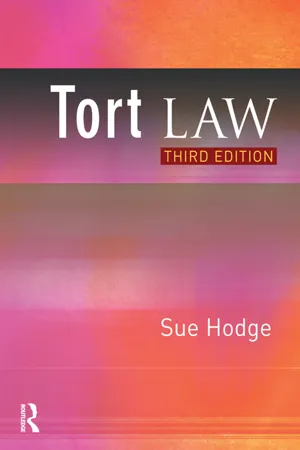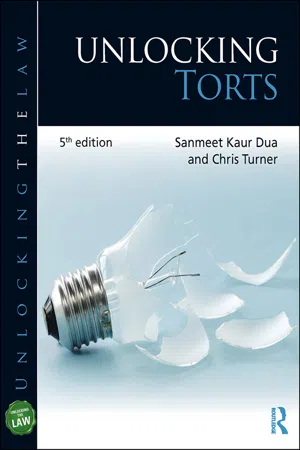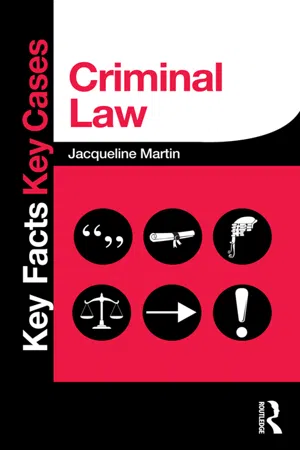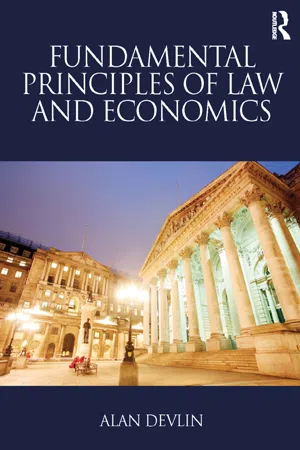Law
Absolute Liability
Absolute liability refers to a legal doctrine holding individuals or entities responsible for damages or injuries regardless of fault or intent. In cases of absolute liability, the focus is on the fact that harm occurred rather than the defendant's actions or state of mind. This principle is often applied in situations involving hazardous activities or products.
Written by Perlego with AI-assistance
Related key terms
1 of 5
4 Key excerpts on "Absolute Liability"
- 7 Strict liability The concept of strict liabilityThe words ‘strict liability’ can lead to some confusion. Most torts require an element of fault on the part of the alleged wrongdoer but in a tort of strict liability fault is largely irrelevant. If the wrong has occurred, the defendant will be liable, regardless of blame. This does not mean that there can be no defence, although the available defences may be limited. This part of the book looks at two areas of strict liability, liability for animals and liability for dangerous products. Both are statutory torts and both are subject to statutory defences which mean that the wrongdoer can escape liability.Liability for animalsThe law is found in the Animals Act 1971 and in the common law. The basic assumption is that because animals are by their nature unpredictable, a person who keeps an animal does so at his peril. Where, however, the animal is usually domesticated and regarded as harmless, strict liability does not apply unless the animal has given cause to fear that it might be dangerous. Perhaps this was the origin of the saying that ‘every dog is allowed one bite!’, although as we shall see this is not strictly true.Who is liable? The Animals Act 1971 imposes strict liability on the ‘keeper’ of an animal. By s.6(3) a person is a keeper of an animal if:
(a) he owns the animal or has it in his possession; or (b) he is the head of a household of which a member under the age of sixteen owns the animal or has it in his possession. If an animal strays the original keeper remains liable until another person fulfils the definition. If the animal is taken into safe-keeping to prevent it from causing damage or until it can be returned to the keeper, the temporary owner is not regarded as the keeper. - eBook - ePub
- Sanmeet Kaur Dua, Chris Turner(Authors)
- 2019(Publication Date)
- Routledge(Publisher)
strict liability. In such cases there is no requirement to show that the defendant was at fault. Torts of strict liability include liability under the Consumer Protection Act 1987 and the Animals Act 1971. Where the requirements of the tort have been fulfilled, the defendant will be liable even though in reality there is no fault in the sense of intention or negligence. It would, however, be wrong to say that a defendant who is in breach of a particular requirement is always liable. While the torts may impose ‘strict liability’ defences are usually available even if they are limited. Liability is ‘strict’ not ‘absolute’.For a detailed discussion of the merits and demerits of a fault-based system in the context of negligence where it causes most difficulty, see Chapter 3 . The reader is also referred to Chapter 11 on Rylands v Fletcher for an interesting tort which started life as a tort of strict liability, but now appears to have changed its character to become fault based!1.3.3 No-fault schemes
The problems faced by claimants who need to prove fault have already been highlighted. The question arises ‘Is the law always an appropriate tool to deal with wrongful behaviour which causes damage?’This question was considered by the Royal Commission on Civil Liability and Compensation for Personal Injury (Cmnd 7054, 1978) which is from now on referred to as the Pearson Committee. The report showed that at that time the number of people suffering serious injury or death was around 3,000,000 each year of whom something under 250,000 made a claim in torts. Taking into account all sources of compensation, this small proportion of the total number of victims actually received about 25 per cent of all monies paid for accidental injury. The Pearson Committee also found that the costs of the torts system were disproportionate to the amount paid to claimants and that administrative costs swallowed up a larger percentage of the budget than the costs of other sources for compensation, for example the social security system. There was no doubt then, nor is there now, that where compensation for a tort is paid, the claimant will in fact receive a greater sum than from other sources. In summary the Pearson Committee found that - eBook - ePub
- Jacqueline Martin(Author)
- 2014(Publication Date)
- Taylor & Francis(Publisher)
4 Strict liability4.1 Absolute Liability1 This is very rare.2 The offence requires no mens rea.3 The defendant’s actus reus need not be voluntary (Winzar (1983) ,Larsonneur (1933)).4.2Strict liability1 Neither mens rea nor negligence need be proved in respect of one or more elements of the actus reus.2 The actus reus must be proved.3 The defence of mistake is not available.4.3 Common law strict liability offences1 Strict liability is very rare in common law offences.2 Public nuisance and criminal libel probably do not require mens rea, but there are no modern cases.3 Outraging public decency is a strict liability common law offence (Gibson and Sylveire (1990)).4 Criminal contempt of court was a strict liability offence at common law.5 It is now a statutory offence and Parliament has continued it as a strict liability offence.4.4 Statutory strict liability offences1 - eBook - ePub
- Alan Devlin(Author)
- 2014(Publication Date)
- Taylor & Francis(Publisher)
• Generally, the law declines to substitute a particular defendant’s attributes for those of an average person because it is expensive and error-prone to estimate the cost of taking care for each individual before the court. Exceptions arise when it is easy to tell that a person’s cost of achieving a certain reduction in expected accident costs is higher or lower than normal. Thus, for example, the law does not hold children to the same level of care as adults.• The law will only hold a person liable in tort if he injures someone. This “harm requirement” helps to create marginal deterrence, encouraging a person acting negligently along a particular dimension of conduct to take what other steps are available to minimise the likelihood of injury. It also reduces the number of lawsuits filled, thus saving on litigation costs.• The foreseeability requirement absolves an injurer of liability if no discernible causative relationship existed ex ante between the negligent conduct and the ensuing injury. Tort law creates valuable incentives only insofar as a rational actor could determine that altering her behaviour in a particular way would change the likelihood of an accident. Punishing utility-producing behaviour for a random result is unlikely to advance social welfare.• Limiting the duty of care to reasonably foreseeable harm to a proximate victim may be an efficient proxy for unilateral-care scenarios in which victims are the lowest cost avoiders.• Custom is a reliable shorthand for due care only where potential tortfeasors and accident victims regularly contract with one another, and where harms result from those contractual relations. In other settings, customs may incorporate negative externalities that the law should try to eliminate.• Assumption of risk absolves a defendant of responsibility where the plaintiff embraced the danger inherent in the defendant’s conduct. Its economic function is to eliminate liability in unilateral-care scenarios where victims are the lowest cost avoiders.• Product defects are subject to strict liability, which economics justifies on account of forcing manufacturers to include in the price of their goods a premium reflecting the non-eliminable risk of a defect. That price increase signals valuable information to consumers about product risk, causing them to substitute toward safer goods. Nevertheless, as strict liability increases the number of lawsuits filed and may have only a modest effect on incentives to take care, some economists conclude that negligence would be the superior rule.
Index pages curate the most relevant extracts from our library of academic textbooks. They’ve been created using an in-house natural language model (NLM), each adding context and meaning to key research topics.



